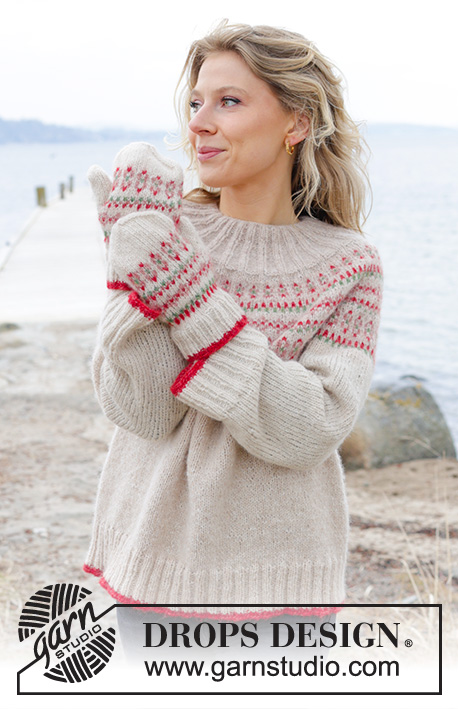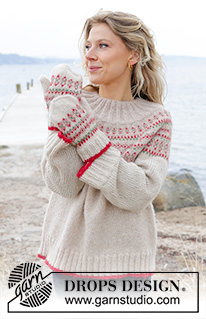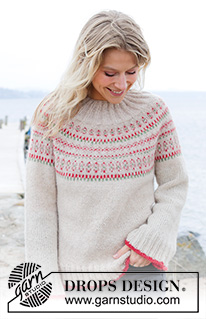Comments / Questions (16)
![]() Ytze Strous wrote:
Ytze Strous wrote:
Hoe moet ik de steken meerderen in de zijkant onder de mouw?
04.07.2025 - 10:30DROPS Design answered:
Dag Ytze,
Dit staat bovenaan de beschrijving aangegeven bij tip voor het meerderen voor de mouw.
04.07.2025 - 19:12
![]() Emmy wrote:
Emmy wrote:
Waar kan ik het garen bestellen voor deze trui? Met vriendelijke groet, Emmy
20.02.2025 - 16:59DROPS Design answered:
Dag Emmy,
Het bestellen van garens gaat via een van de verkooppunten die onze artikelen verkopen; wij verkopen geen garens via de site. Via deze link vind je een lijst met verkooppunten.
20.02.2025 - 21:40
![]() Åsa wrote:
Åsa wrote:
Maskeantall stemmer før mig men førstår nu av ditt svar att mønstret inte blir symmetriskt, ska bara var så.
20.01.2025 - 16:35
![]() Åsa wrote:
Åsa wrote:
Efter ha ökt på ok/ bolen PIL2 från 160 masker till 176 så stämmer inte mönstret när jag ska fortsätta sticka efter det som står på A1. Jag kommer ingen vart. snälla hjälp vad är det för fel ??
19.01.2025 - 20:02DROPS Design answered:
Hei Åsa. Hvilken str. strikker du og har du riktig maskeantall? Husk at når du øker masker, så kan det være at maskene du ser på diagrammet ikke stemmer overens med det du strikker, men har en liten forskyvning pga økte masker, men det er ingen feil. mvh DROPS Design
20.01.2025 - 13:40
![]() Sophie wrote:
Sophie wrote:
I wish the instructions had made it clear that pattern A1 was supposed to be followed from down upwards. I did it the opposite way, and the increases therefore came at the wrong places. There are a lot of references to top down, and since the whole jumper is knitted top down, it sr Eems logical to follow the pattern top down!
06.12.2024 - 07:08
![]() Andrea Thöne wrote:
Andrea Thöne wrote:
Hallo, ich habe die deutsche Größe 40/42 trage Pullis gerne größer: Soll ich XL oder XXL nehmen?
10.11.2024 - 15:16DROPS Design answered:
Liebe Frau Thöne, am besten messen Sie einen ähnlichen Pullover den Sie gerne tragen und vergleichen Sie diese Maßnahmen mit den in der Skizze, so finden Sie die richtige Grösse, hier lesen Sie mehr. Viel Spaß beim Stricken!
11.11.2024 - 09:34
![]() Cindy De Permentier wrote:
Cindy De Permentier wrote:
Hallo! Ik vraag me af welke maat het model op de foto draagt. En hoe groot deze persoon ook is. Het zou kunnen helpen om de juiste maat voor mezelf te bepalen.
04.10.2024 - 08:55DROPS Design answered:
Dag Cindy,
Het model op de foto draagt maat S.
19.10.2024 - 11:41
![]() Bente Pia Elise Jensen wrote:
Bente Pia Elise Jensen wrote:
Hei. Jeg lurer på når det står at jeg skal dele bol fra ermer, det står 28 cm fra merket. Hvilket merke mener dere? Fra når halskant er ferdig? ( Når A.1 er strikket ferdig i høyden, strikkes det 1 omgang med fargen hvete der det økes 20-20-24-28-28-32 masker jevnt fordelt = 256-276-296-324-344-364 masker. Strikk glattstrikk videre med fargen hvete. Når arbeidet måler 25-26-28-30-32-34 cm fra merket, deles det til bol og ermer som forklart under) Dette jeg ikke forstår helt. Bente
25.03.2024 - 11:50DROPS Design answered:
Hej Bente, Strikk til vrangborden måler 3 cm. Sett 1 merke på begynnelsen av omgangen (= midt bak), bærestykket skal måles fra dette merket! :)
04.04.2024 - 15:15
![]() Gabriele Schaefer wrote:
Gabriele Schaefer wrote:
Sehr gut beschrieben. Pulli sieht toll aus. Wolle reicht auch. Ärmel müssen länger gestrickt werden. Ansonsten stimmen die Maße. Danke
13.01.2024 - 10:37
![]() Lilith71 wrote:
Lilith71 wrote:
Vielen Dank für diese tolle Anleitung! Ich habe Größe M gestrickt und passt perfekt 👍Liebe Grüße💖
16.12.2023 - 06:38
Something About Holly Sweater#somethingabouthollysweater |
|||||||||||||
 |
 |
||||||||||||
Knitted jumper in DROPS Air. The piece is worked top down with round yoke and multi-coloured pattern. Sizes S - XXXL.
DROPS 245-19 |
|||||||||||||
|
------------------------------------------------------- EXPLANATIONS FOR THE PATTERN: ------------------------------------------------------- PATTERN: See diagram A.1. Choose diagram for your size. The diagram shows all rows in the pattern from the right side. INCREASE TIP (evenly spaced): To work out how to increase evenly, count the total number of stitches on the needle (e.g., 132 stitches) and divide by the number of increases to be made (e.g., 16) = 8.25. In this example, increase by making 1 yarn over after approx. each 8th stitch. On the next round knit the yarn overs twisted to avoid holes. DECREASE TIP (for sleeves): Decrease 1 stitch on each side of the marker-thread as follows: Work until there are 3 stitches left before the marker-thread, knit 2 together, knit 2 (marker-thread sits between these 2 stitches), slip 1 stitch knit-wise, knit 1 and pass the slipped stitch over the knitted stitch. ------------------------------------------------------- START THE PIECE HERE: ------------------------------------------------------- JUMPER – SHORT OVERVIEW OF THE PIECE: The neck and yoke are worked in the round, from mid back and top down. The yoke is divided for body and sleeves and the body is continued in the round. The sleeves are worked in the round with short circular needle/double pointed needles. NECK: Cast on 88-96-96-100-104-108 stitches with circular needle size 4 mm and colour wheat DROPS Air. Knit 1 round, then work rib in the round (knit 2, purl 2) for 3 cm. Insert 1 marker at the beginning of the round (mid-back); the piece is measured from this marker! Now increase by making 1 yarn over at the beginning of each purled section = 110-120-120-125-130-135 stitches. Continue the new rib (knit 2, purl 3), purling the yarn overs twisted on the first round. When the neck measures 2½ cm from the marker, make 1 yarn over at the end of each purled section = 132-144-144-150-156-162 stitches. Continue the new rib (knit 2, purl 4), purling the yarn overs twisted on the first round. When the neck measures 5-5-5-6-6-6 cm from the marker. The neck measures 8-8-8-9-9-9 cm from the cast-on edge. YOKE: Change to circular needle size 5 mm. Work A.1 over all stitches. REMEMBER THE KNITTING TENSION! On each round with an arrow in the diagram, increase as follows: ARROW-1: Increase 16-16-20-26-28-30 stitches evenly spaced = 148-160-164-176-184-192 stitches. ARROW-2: Increase 16-16-20-24-24-28 stitches evenly spaced = 164-176-184-200-208-220 stitches. ARROW-3: Increase 16-20-20-24-24-28 stitches evenly spaced = 180-196-204-224-232-248 stitches. ARROW-4: Increase 16-20-20-24-28-28 stitches evenly spaced = 196-216-224-248-260-276 stitches. ARROW-5: Increase 20-20-24-24-28-28 stitches evenly spaced = 216-236-248-272-288-304 stitches. ARROW 6: Increase 20-20-24-24-28-28 stitches evenly spaced = 236-256-272-296-316-332 stitches. When A.1 is finished in height, knit 1 round with colour wheat and increase 20-20-24-28-28-32 stitches evenly spaced = 256-276-296-324-344-364 stitches. Continue with stocking stitch and colour wheat. When the piece measures 25-26-28-30-32-34 cm from the marker, divide for the body and sleeves as follows: Knit 38-41-44-48-52-56 (half back piece), place the next 52-56-60-66-68-70 stitches on 1 thread for the sleeve, cast on 6-6-8-8-10-12 stitches (in side under sleeve), knit 76-82-88-96-104-112 (front piece), place the next 52-56-60-66-68-70 stitches on 1 thread for the sleeve, cast on 6-6-8-8-10-12 stitches (in side under sleeve), knit the remaining 38-41-44-48-52-56 stitches (half back piece). The body and sleeves are finished separately. The piece is now measured from here! BODY: = 164-176-192-208-228-248 stitches. Continue in the round with stocking stitch and colour wheat for a further 21-22-22-22-22-22 cm (8 cm left; try the jumper on and work to desired length). Knit 1 round and increase 32-32-36-40-44-48 stitches evenly spaced – remember INCREASE TIP = 196-208-228-248-272-296 stitches. Change to circular needle size 4 mm and work rib (knit 2, purl 2) for 7 cm. Knit 2 rounds with colour crimson red, cast off a little loosely. The jumper measures approx. 58-60-62-64-66-68 cm from the shoulder. SLEEVES: Place the 52-56-60-66-68-70 stitches from the thread on the one side of the piece on short circular needle/double pointed needles size 5 mm and knit up 1 stitch in each of the 6-6-8-8-10-12 stitches cast on under the sleeve = 58-62-68-74-78-82 stitches. Insert a marker-thread in the middle of the new stitches under the sleeve; allow it to follow your work onwards. It is used when decreasing under the sleeve. Start at the marker-thread and work stocking stitch in the round with colour wheat. When the sleeve measures 3 cm, decrease 2 stitches under the sleeve – read DECREASE TIP. Decrease like this every 8-6-4-2½-2-2 cm a total of 4-5-7-10-10-11 times = 50-52-54-54-58-60 stitches. Continue working until the sleeve measures 32-31-30-28-27-25 cm from the division (or to desired length. There is approx. 8 cm left). Knit 1 round and increase 10-8-10-10-10-8 stitches evenly spaced = 60-60-64-64-68-68 stitches. Change to double pointed needles size 4 mm and work rib (knit 2, purl 2) for 7 cm. Knit 2 rounds with colour crimson red. Cast off a little loosely. The sleeve measures approx. 40-39-38-36-35-33 cm. Work the other sleeve in the same way. |
|||||||||||||
Diagram explanations |
|||||||||||||
|
|||||||||||||

|
|||||||||||||

|
|||||||||||||
Have you finished this pattern?Tag your pictures with #dropspattern #somethingabouthollysweater or submit them to the #dropsfan gallery. Do you need help with this pattern?You'll find 29 tutorial videos, a Comments/Questions area and more by visiting the pattern on garnstudio.com. © 1982-2025 DROPS Design A/S. We reserve all rights. This document, including all its sub-sections, has copyrights. Read more about what you can do with our patterns at the bottom of each pattern on our site. |
|||||||||||||













































































Post a comment to pattern DROPS 245-19
We would love to hear what you have to say about this pattern!
If you want to leave a question, please make sure you select the correct category in the form below, to speed up the answering process. Required fields are marked *.